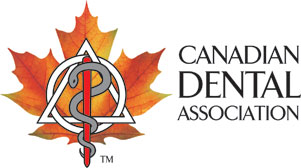There are a wide variety of over-the-counter and professional products for whitening teeth, including gels, pastes, strips, gums and rinses. This position statement focuses on products that whiten teeth through bleaching, which is a chemical process that cannot be immediately reversed. Products that whiten teeth by mechanically removing debris or stains, such as toothpastes and gums, are not considered in this statement.
Position
For individuals who are thinking about bleaching their teeth, careful consideration should be given to the following:
- Consult a dentist, who can assess the cause of tooth discolouration and the best approach to achieving whiter teeth. If, after the consultation, the patient decides to proceed with tooth bleaching, the procedure should be performed under a dentist’s supervision and according to the manufacturer’s directions.
- Bleaching is not appropriate for teeth that are demineralized or have decay. Other forms of tooth discolouration include and may be caused by natural aging, staining from food, drink, smoking, fluorosis, opacities, trauma, or medications. Other approaches to whitening may need to be considered first. Caution should also be used with sensitive teeth.
- Bleaching does not whiten dental work like crowns, fillings, and dentures. There is a possibility that dental work may appear darker following bleaching of your natural teeth.
- For patients with tooth discolouration that occurred during disrupted development, a blow to a tooth or later in life (such as discolouration caused by tetracycline staining, fluorosis, sports accident or fall, or normal aging), bleaching may yield irregular and unsatisfactory results. Other approaches to achieving a whiter, even appearance may be required.
- Research has demonstrated that the whitening effect of tooth bleaching can last up to three years and is affected by smoking and consumption of food or drinks that stain teeth.
- The degree to which teeth appear whiter, depends on the original reason that caused the discoloration, and the evenness of shading and the speed at which the change occurs depend on the concentration of the bleaching chemicals and the technique (e.g., use of mouth-guard tray, strip delivery or paint-on method).
- Current literature does not indicate that power- or light-assisted (laser) bleaching produces whiter teeth, although the bleaching process occurs more quickly with these methods.
-
Bleaching may cause negative effects. When products are used as directed, some tooth sensitivity and soft-tissue irritation are the most common short-term effects. If sensitivity and soft tissue irritation persists, grows worse or other side effects occur you should stop using the product and consult your dentist. There is some evidence to indicate that after bleaching,
- the enamel will temporarily soften,
- certain types of fillings stain more easily,
- the colour of the fillings may no longer match the change in tooth colour, and
- or the seal of composite fillings and bonded orthodontic brackets may be affected because there is evidence that bleaching reduces bond strength.
- Repeated bleaching, beyond the initial treatment) is not recommended as the long-term effects are not yet fully understood and it may lead to tooth pitting and pulp (“nerve”) damage.
- Tooth bleaching should be deferred until after pregnancy because it is an elective treatment and bleaching products have not been tested in pregnant women.
- Bleaching products should only be considered after careful discussion with a dentist.
CDA Board of Directors
Approved: November 2007
5 year review Approved: February 2019











